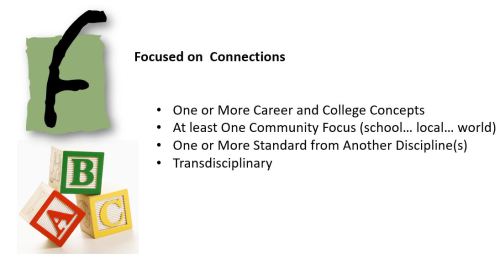F is for Focused on Connections: The ABC’s of PBL … Building Blocks to Transform Learning


Welcome to this sixth post in a series that promotes PBL and 21st Century Learning through the examination of Seven Building Blocks. In this sixth post, I feel it is important to point out the importance of connecting learning both inside and outside of the curriculum. When we connect the dots with students a new level of real understanding is possible. Before reading, please take a moment to subscribe by email or RSS, and also give me a follow… on Twitter at mjgormans. I promise you will find some wonderful information coming your way in the posts that follow…So sign up now and please pass this on with a retweet. Also, remember you can book me for a conference or your school district with workshops that are informative, engaging, and practical. Check out my Booking Page and as always… thanks so much! I am taking dates for 2018 with 2017 full… in fact 2018 dates are going fast! Mike Gorman (https://21centuryedtech.wordpress.com/)
F is for Focused on Connections: The ABC’s of PBL … Building Blocks to Transform Learning by Michael Gorman at https://21centuryedtech.wordpress.com/
Knowledge does not thrive in isolation. In fact, content knowledge is only useful to students when applied to concepts found outside the classroom. For students, PBL allows for connections that provide important links from their knowledge acquisition to their real world experiences. Sometimes these connections allow student to use areas of past knowledge to understand and construct new knowledge… many times the role of a PBL Launch or Entry Event. Equally important are connections to future career and college possibilities. While interdisciplinary planning is not a prerequisite for effective PBL, such design and planning can show students that subjects are connected and intertwined. This can be difficult in many school settings and it is recommended that a teacher’s very first project possibly be initiated in their subject area without a team approach. Even in this way a teacher could show connections by bringing in other subject standards, career/ college possibilities, and connections to community. As teachers become more proficient they may branch out and begin to design multidiscipline projects with other teachers. Perhaps the most exciting possibilities in education come with a questions that brings in all the disciplines as can be found in Transdisciplinary Learning. While this may not be a starting place it could be a long term vision. As we travel this journey remember the statement by John Dewey, “Method means that arrangement of subject matter which makes it most effective in use. Never is method something outside of the material.”
1. One or More Career and College Concepts
2. At least One Community Focus (school… local… world)
3. One or More Standards from Another Discipline(s)
4.Transdisciplinary (connections by question)
One or More Career and College Concepts – While students become exposed to content standards they may begin to find areas of interests, strengths, and passion. A PBL project might allow a student to discover such future possibilities while addressing the pathways needed to seek out their interests. It might even be the final project reflection that causes students to take a future course. Other concepts could be career related skills that employers so much want to see in their future workforce. PBL can allow students to experience, practice, and perfect such skills. Note the emphasis of career first… college is really just one pathway.
At least One Community Focus (school… local… world) – Connecting to the community outside of the classroom is essential to PBL. It is often the motivating factor in creating quality work. It is always rewarding to perform work, obtain skills, and learn content that makes a real difference to the world. The community might extend to a classroom down the hall, another school in the district, the local community, or the world. Best of all technology provides new and amazing ways to create new possibilities in this connection.
One or More Standards from Another Discipline – Students need to see how the disciplines they study in school do not stand in isolation, but are integrated. Teachers do not have to team teach to make this a possibility. Through collaboration and planning they can share a few of those important power standards. Imagine the power of students seeing the same concepts in more than one subject. PBL can make this a possibility allowing schools to focus on some of those more difficult standards through multiple disciplines.
Tools and ideas to transform education. Sign up below.
Transdisciplinary – The idea of merging multiple classes together for a time period could be powerful and allow student to see new connections which may help support understanding. This type of team teaching is not always possible in every schedule, but teachers can share the same students through different class periods. In either case, there must be some deliberate attempt to create a master schedule that allows for sharing of students and teacher planning time. A Transdisciplinary approach demands that the project be designed with an over-arcrching question that is answered through the connected disciplines. There is a real authenticity because the question realy does drive the standards regardless of the discipline. This is one of the ultimate goals as educators advance in the PBL process.
Reflection on Focused on Connections
Allowing students to see connections outside of the content standards is an important theme found in PBL. There are multitudes of ways to facilitate connections as highlighted in these indicators. It only when connections are made that learning becomes meaningful and students become engaged to the purpose of deeper learning. As the culture of PBL permeates the classroom it is exciting to watch the excitement in students as they begin to make their own connections.
Resources For Focused on Connections
- Finland Research Article – Read how Finland is pushing to ditch single class subjects.
- Roots and Shoots – Jane Goodall’s Roots & Shoots is the Jane Goodall Institute’s (JGI) global youth-led community action program, comprised of thousands of young people as they connect knowledge and service with the real world.
- Transdisciplinary Learning – How does Transdisciplinary learning really differ from Interdisciplinary learning. Read this from the IB Schools.
- College and Career Ready from Achieve – Created in 1996 by a bipartisan group of governors and business leaders, Achieve is a nonprofit education organization that has spent two decades leading the effort to help states make college and career readiness a priority for all students.
- Edutopia Resources for Building Community Partnerships – Learn how schools can benefit from the support and expertise of local businesses, organizations, and individuals, and discover strategies for fostering successful business and community partnerships
- Entry Events for PBL – An entry event or project launch can help make connections between what students already know and what they are going to learn. Learn more about how to make this connection even more powerful.
- ePals – Another wonderful stite allowing students to collaborate across the globe. Check out the amazing possibilities.
- Taking it Global – Visit one of the world’s leading networks of young people learning about, engaging with, and working towards tackling global challenges.
- The Globe Program – Take a look at this organization that inspires topromote the teaching and learning of science, enhance environmental literacy and stewardship, and promote scientific discovery.
cross-posted at 21centuryedtech.wordpress.com
Michael Gorman oversees one-to-one laptop programs and digital professional development for Southwest Allen County Schools near Fort Wayne, Indiana. He is a consultant for Discovery Education, ISTE, My Big Campus, and November Learning and is on the National Faculty for The Buck Institute for Education. His awards include district Teacher of the Year, Indiana STEM Educator of the Year and Microsoft’s 365 Global Education Hero. Read more at 21centuryedtech.wordpress.com.
